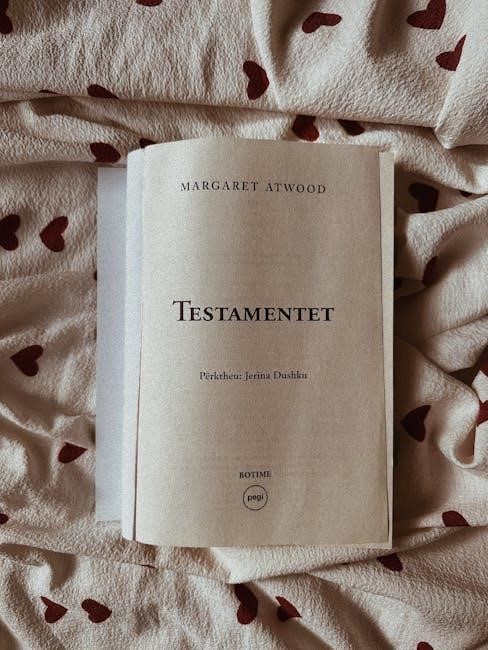Act 1 of The Crucible sets the stage in Salem, introducing Reverend Parris, Abigail, and Betty amidst rising tensions. It establishes the fear of witchcraft and the societal hysteria, laying the groundwork for the ensuing dramatic events and moral dilemmas.
Setting of Act 1
Act 1 of The Crucible is set in a small, dimly lit bedroom in Reverend Samuel Parris’s house in Salem, Massachusetts, during the spring of 1692. The room contains a narrow window, a bed where Betty Parris lies unconscious, and minimal furnishings, reflecting the austere Puritan lifestyle. The atmosphere is tense and filled with fear, as the community is gripped by the threat of witchcraft. This setting establishes the play’s historical context and creates an eerie, foreboding mood, highlighting the societal hysteria and religious fervor that dominate Salem during this time.

Key Characters Introduced in Act 1
Act 1 introduces Reverend Samuel Parris, a strict and worried priest; Abigail Williams, his manipulative niece; and Betty Parris, his ailing daughter, central to the unfolding drama.

Reverend Samuel Parris
Reverend Samuel Parris is a rigid and self-righteous minister whose primary concern is his reputation and social standing in Salem. In Act 1, he is frantic over his daughter Betty’s mysterious illness, fearing it may be linked to witchcraft. Parris is deeply worried about how this situation could tarnish his image and threaten his position in the community. His interactions with Abigail and Tituba reveal his authoritarian nature and his tendency to blame others for his problems. Parris’s actions are driven by fear, pride, and a desire to maintain control, setting the stage for the conflicts that will unfold in the play.
Abigail Williams

Abigail Williams, a 17-year-old servant in the Parris household, is a manipulative and vengeful character. She is fiercely independent and harbors a deep resentment toward her uncle, Reverend Parris. Abigail’s past as John Proctor’s former servant and lover adds complexity to her motivations, as she seeks revenge against Elizabeth Proctor. Her fear of punishment for dancing in the forest drives her to accuse others of witchcraft, showcasing her cunning and ability to manipulate situations to her advantage. Abigail’s actions in Act 1 set the stage for the escalating hysteria and false accusations that dominate the play, revealing her as a central figure in the unfolding drama.
Betty Parris
Betty Parris, the 10-year-old daughter of Reverend Samuel Parris, falls into a mysterious trance after dancing in the forest with Abigail and other girls. Her unresponsive state heightens the tension and fear within the household, as her father and others suspect witchcraft. Betty’s condition worsens as the act progresses, symbolizing the escalating hysteria in Salem. Her inability to awaken and her subsequent convulsions create an atmosphere of dread, prompting accusations and sparking the chain of events that drives the play. Betty’s vulnerability and fear make her a tragic figure, caught in the crossfire of Abigail’s manipulation and the community’s paranoia.

Major Conflicts in Act 1
The fear of witchcraft sparks accusations and hysteria, while personal conflicts, especially between Parris and Abigail, escalate tensions in the community, driving the plot forward.
The Fear of Witchcraft
The fear of witchcraft dominates Act 1, creating widespread hysteria and paranoia in Salem. Reverend Parris’s daughter Betty falls ill, and rumors of witchcraft spread rapidly, fueled by the community’s deep-seated beliefs. Abigail Williams defends herself against accusations, insisting that their dancing was harmless, but the fear of witchcraft escalates tensions. The villagers, driven by superstition and fear, begin to suspect others of practicing witchcraft, setting the stage for a wave of accusations. This fear not only disrupts the community but also highlights the dangerous power of unchecked paranoia and the societal need to identify and punish perceived threats.
The Conflict Between Parris and His Niece Abigail
The tension between Reverend Parris and Abigail Williams is evident in Act 1, as Parris confronts her about the forbidden dancing in the forest. Abigail defends herself, explaining that Betty fainted due to fear, but Parris remains suspicious and worried about his reputation. Their argument reveals underlying strained relations, with Abigail resenting Parris’s strictness and Parris fearing scandal. This conflict escalates as Abigail shifts blame to Tituba, showcasing her manipulative nature and setting the stage for further discord. Their interaction highlights the oppressive atmosphere and the strained family dynamics, contributing to the play’s escalating tensions and moral complexities.

Themes Explored in Act 1
Act 1 introduces themes of fear, hysteria, and the destructive power of unchecked accusations, highlighting the oppressive role of religion and societal judgment in Salem.
The Power of Fear and Hysteria
Act 1 of The Crucible vividly portrays the power of fear and hysteria in Salem, 1692. The mysterious illness of Betty Parris and the discovery of the girls dancing in the forest ignite a wave of fear, leading to accusations of witchcraft. Abigail’s attempts to explain the situation are overshadowed by the growing suspicion and panic among the community. Reverend Parris’s frantic reaction and the villagers’ readiness to believe in supernatural forces highlight how fear can escalate into mass hysteria. This fear-driven environment sets the stage for the chaos and destruction that unfolds, as individuals prioritize self-preservation over truth and reason.

The Role of Religion in Salem Society
Religion plays a central role in Salem society, as depicted in Act 1 of The Crucible. The Puritan community’s strict religious beliefs establish a rigid moral code, influencing their reactions to events. The fear of witchcraft is deeply tied to religious convictions, with deviations from Puritan norms being viewed as signs of evil. Religious leaders like Reverend Parris amplify these fears, shaping the community’s behavior and contributing to the emerging hysteria. This religiously charged environment fosters an atmosphere where accusations of witchcraft thrive, highlighting the significant impact of religion on the societal dynamics of Salem.

The Dangers of False Accusations
In Act 1 of The Crucible, the dangers of false accusations are evident through Abigail’s manipulative behavior and the community’s willingness to believe her claims. Abigail’s false confession about witchcraft sets off a chain reaction, fueled by fear and hysteria. The townspeople’s gullibility and eagerness to blame others for unexplained events highlight the destructive power of unchecked accusations. This theme is central to the play, as it reveals how false claims can escalate into chaos, ruining reputations and lives. The act underscores the importance of critical thinking and the need for evidence in a society prone to irrational fear and superstition.

Significance of Act 1 in the Overall Play
Act 1 introduces the central conflict, key characters, and themes, setting the tone for the play. It establishes the fear of witchcraft and the societal tensions that drive the plot forward, making it crucial for understanding the events that unfold.
Setting the Tone for the Rest of the Story

Act 1 establishes a tense and foreboding atmosphere, introducing the oppressive societal norms of Salem. The setting of Reverend Parris’s house, with its narrow window and dimly lit bedroom, reflects the claustrophobic and judgmental environment of the Puritan community. The eerie scene of Betty’s unexplained illness and the whispers of witchcraft create a sense of dread and hysteria. This opening act lays the groundwork for the escalating fear and paranoia that will dominate the rest of the play, highlighting the destructive power of unchecked emotions and false accusations.
Introducing the Central Conflict
Act 1 of The Crucible introduces the central conflict through the unfolding events in Salem. The mysterious illness of Betty Parris and the rumors of witchcraft spark fear and suspicion within the community. Reverend Parris’s concern for his daughter’s health and his reputation intertwines with Abigail’s hidden motives, creating tension. The accusations of witchcraft emerge as a tool for revenge and manipulation, setting the stage for the moral and societal conflict that will drive the play. This act establishes how fear, superstition, and personal grievances escalate into a widespread crisis, highlighting the destructive potential of unchecked accusations.
Act 1 of The Crucible effectively sets the stage for the events that will unfold, introducing key characters, conflicts, and themes. The fear of witchcraft and the emerging hysteria in Salem are central to the act, as are the personal tensions between Parris, Abigail, and Betty. By establishing these elements, Act 1 creates a foundation for exploring the destructive power of fear, false accusations, and societal pressure. The act concludes with a sense of escalating tension, hinting at the moral and emotional turmoil that will dominate the rest of the play. It serves as a compelling introduction to the dark and dramatic events that will follow.